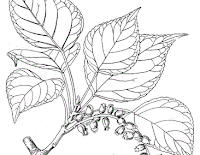Oaks, Quercus spp., are one of the largest groups of trees today, forming an important part of the temperate forests of the Northern Hemisphere, but reaching their most diverse in the tropical dry forests of Southeast Asia and Central America. Red Oaks of the Section Lobatae are endemic to the Americas. They are evergreens, with bristles or prickles on their leaves, and acorns born in scaly cups.
In a paper published in the journal Phytotaxa on 3 August 2016, Susana Valencia-A of the Herbario de la Facultad de Ciencias at the Universidad Nacional Autónoma de México and Jose Luciano Sabas Rosales and Oscar Javier Soto Arellano of the Herbario of the Instituto Nacional de Estadística y Geografía describe a new species of Red Oak from the Sierra Madre Oriental of Mexico.
The new species is named Quercus meavei in honour of Jorge Arturo Meave del Castillo, for his work on the botany of the cloud forests and other tropical zones of Mexico. It grows as a tree 20-30 m in height. The trees are found in temperate forests and Oak forests in areas of high humidity and along river banks in the Sierra Madre Oriental in Hidalgo, Puebla, San Luis Potosí and Veracruz states, at altitudes of 1630–2250 m. The trees flower in March, with acorns maturing in September to November.
Quercus meavei, branchlet with leaves and fruits. Valencia-A et al. (2016).
See also...
 Understanding the role of Bears in enabling a Cherry tree to migrate up mountains. The Earth's climate is known to fluctuate over time, requiring animals
and plants to move in order to find suitable habitats. For animals this
is a fairly easy task, since most animals constantly move in search of
the optimum environments during their lives, however...
Understanding the role of Bears in enabling a Cherry tree to migrate up mountains. The Earth's climate is known to fluctuate over time, requiring animals
and plants to move in order to find suitable habitats. For animals this
is a fairly easy task, since most animals constantly move in search of
the optimum environments during their lives, however... Populus × jrtyschensis: Understanding the origin of a hybrid Poplar population from Xinjiang Province, China. Hybridization between
species is rare in animals, but a fairly common occurrence in many
plants, with related plant species often having hybridization zones
between populations of related...
Populus × jrtyschensis: Understanding the origin of a hybrid Poplar population from Xinjiang Province, China. Hybridization between
species is rare in animals, but a fairly common occurrence in many
plants, with related plant species often having hybridization zones
between populations of related... Prunus kunmingensis: Peaches from the Late Pliocene of Yunnan Province. Peaches, Prunus persica, are widely grown and consumed fruit
around the world today, with a total annual production of about 20
million tons. They have a long historical association with humans,
particularly in East Asia, with the oldest known...
Prunus kunmingensis: Peaches from the Late Pliocene of Yunnan Province. Peaches, Prunus persica, are widely grown and consumed fruit
around the world today, with a total annual production of about 20
million tons. They have a long historical association with humans,
particularly in East Asia, with the oldest known...
Follow Sciency Thoughts on Facebook.

